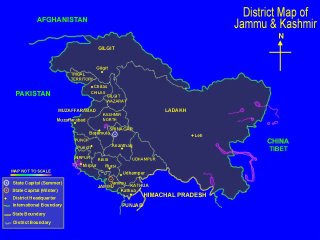|
|
Kashmir
Valley History
Due
to its isolation in the high valley of the Himalayas, Kashmir
has over the centuries developed an independent cultural and
historical tradition.
Buddhism became established in Kashmir quite early. Ashoka was
its main promulgator. Around the time of the birth of
Christ, the third Buddhist Congress took place in Kashmir and
missionaries were sent to neighbouring regions of Central
Asia, Tibet and China. In the following centuries Buddhism lost
its influence and by the 7th century had almost been replaced
by Hinduism. In the 1300s the Kashmiris changed to the Islamic
religion and a series of Muslim rulers controlled the region.
One of the best known was Zain-ul-Abidin, whose tomb still stands
by the Jhelum River in Srinagar. He was generally known
as Badshah, 'the great king'. He ruled from 1421 to 1472.

With
the conquest of the valley by the Moghul Emperor Akbar in 1586
Kashmir entered a period of stable political conditions and
great cultural activity. The Moghuls chose Kashmir as
their summer residence and built many fine gardens, particularly
under Emperor Jehangir who took the art of designing Moghul
gardens to its greatest heights. As the Moghul period began
its decline the Government of Kashmir becomes practically independent.
In 1756 Kashmir fell to Afghanistan, but in 1819 it was taken
over by the Sikhs who called upon the Kashmiris to aid them
in their struggle against the brutal Afghan rule.
In 1846 the Sikh General Gulab Singh was appointed head of state
by the British in reward for his neutrality in the war between
the British and the Sikhs. Gilgit, Hunza, Nagar and Chitral
were added to the region and under the rule of the Hindu Dogra
dynasty, the state of Jammu and Kashmir becomes more or less
its present shape.
In 1947, India's independence from Britain and the partition
of India and Pakistan caused Kashmir to become the thorn-in-the-side
of India-Pakistan relations, a position it has held ever since.
Since Kashmir was a 'princely state' and theoretically already
independent, the British could nor simply grant it independence
like most of India but had to persuade it to join one side or
other.
Kashmir become one of the three states - the others were Hyderabad
and the tiny principality of Junagadh - whose rulers could not
or would not opt for India or Pakistan, but clutched at the
feeble hope of remaining independent.
Maharaja Hari Singh's decision not to join either country, or
rather his indecision since he was far from being a decisive
ruler, was a fateful one. Kashmir is predominantly Muslim
so on the basis of religion it should clearly have gone to Pakistan.
Geographically it is also more closely aligned to Pakistan than
India.
Return to Top
|


